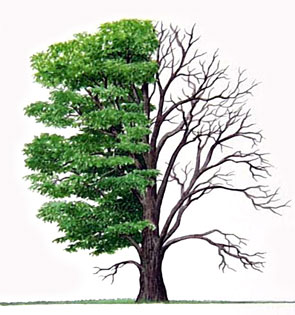TREE PROBLEMS?
| Absolutely Bushed |
Trees can suffer many problems, as can humans. A tree might have disease, poor circulation, parasites (insects… okay, I don’t have a good analogy for humans here), it might be too ‘overweight’, weak, old; undernourished… the list goes on.
Just like a doctor, I can’t accurately assess all tree problems over the phone, but I will try to provide some information for your consideration. Some pest problems have specific symptoms, & are so specific to a species, it can be quite straightforward (if someone calls our office on July 5th, about half the calls are because the client sees a problem on their Magnolia – it’s Magnolia Scale, which simply shows itself more because people have been outside in the yard on their July 4th holiday!)
Other problems are not so obvious – a description on the phone stumps us, so we will visit the property & look at the tree. If necessary, we’ll take leaf/twig samples & send them to a diagnostic clinic for answers.
There are several problem areas relating to trees:
* Foliage
* Trunk
* Roots
* Soil
* Mechanical
Foliage Problems:
“If it looks okay, leave it alone,” some people say. That’s generally good advice for tree care. But if it DOESN’T look okay, pay attention! The foliage is what most people notice, and what can most quickly show problems.
Trunk Problems:
“Would you look at me?” The trunk can be in trouble, too, if there are careless lawnmowers or weed-whackers around. Do you have a dog? Is he/she walked, or left to ‘do its business’ in the yard. Male dogs go for the trees & buildings, & they’re not part of the natural life cycle of a tree >smile<.
Root Problems:
Roots are often overlooked, mostly because they can’t be seen! Many have an ‘out of sight, out of mind’ philosophy. But they’re just as important as any other part of the tree, perhaps more so because they receive the nutrients & moisture from the soil which the tree needs to survive.
Many people believe tree roots must go down deep, to solidly anchor a tree. That’s not quite true, as most tree roots move outwards from the base, going only a foot or two down. Some species have that big, deep root (called a ‘tap root’), but most roots spread out.
As you look down the trunk of the tree, it flares out at the ground level (at least, a healthy tree should). That flare is where the bulk of wood becomes individual large roots, moving away from the base, looking for good soil to live in.
The roots get smaller as they move further away, and somewhere around the dripline of the tree (where rainfall runs off the foliage, ‘dripping’ on the ground, in a curved ‘line’ around the tree), the feeding roots lie, looking for nutrients & moisture.
If there are no nutrients, the roots look farther & farther, which can relate to problems with sidewalks & driveways heaving, basement & pool wall trouble, squeezed or cracked underground pipes, etc…
Soil Problems:
The soil is… it’s… well, it’s more than just dirt; let’s say that, to begin.
The soil is a composite of materials (clay, sand, silt, oxygen, water, macronutrients, micronutrients, & others) which provide the tree with several things – anchorage & nutrient- & moisture-holding capacity are the most obvious.
If a tree is located in poor soil, it may never thrive, no matter what nutrients (fertilizer) are given to it. If the soil is too heavy with clay, nutrients can’t get to the roots, no matter how many nutrients there are. Aeration of the soil will break up the traffic jam & allow them to flow better.
If the soil is too acidic or alkaline for the species, there are methods to change the soil’s PH to better suit the tree.
If the soil is compacted, because of construction equipment, or heavy pedestrian or vehicular traffic (hopefully not a big problem in your backyard!), then again, aeration can break it up & let things move in it (worms can do some of that for you, if you’re a fisherman & can bear to put them back in).
Mechanical Problems:
As mentioned in the soil section above, pedestrian & vehicular traffic can be damaging to a tree’s health. Trees along a sidewalk may provide a rest area for people in the hot summer. Riding lawnmowers (which could be considered vehicles) run over the roots, close to the tree – both compacting the soil a little & possibly ‘bruising’ roots near the surface.
Lawnmowers & weed-whackers can strip bark from the tree, which can be much more damaging than it looks.
Hanging washing lines, flower pots, swing sets, tires, or anything else, does some degree of damage to a tree.
Overpruning can take away too much of the foliage system – the tree must work harder to compensate for the new lack of a physiological balance.
Taking the top off a tree during the summer (particularly big, thick Maples) can expose the ‘inside’ of the crown to the sun – it can get ‘heatstroke’ & ‘sunburn’ as a result.
Poor pruning cuts can cause wounds bigger than good pruning cuts. The tree expends energy to compensate for every wound it gets. The bigger the wound, the more the tree suffers. Always try to prune if possible when your tree is in its dormant stages. If you have to prune it in a growing season be sure to seal the wound with pruning paint. If not, it’s likely to leak sap from the wound and attract unwanted insects to it. I have answered some of your questions directly back to you so check your e-mails!! Until next time…Happy Gardening!

